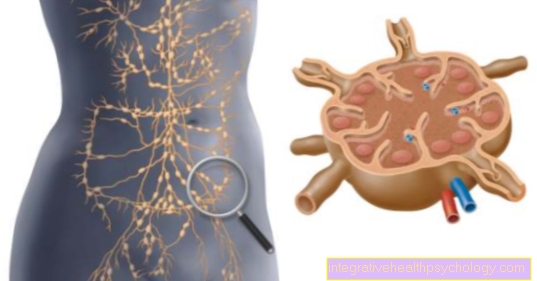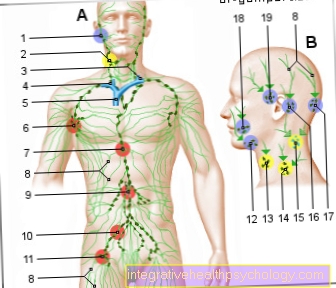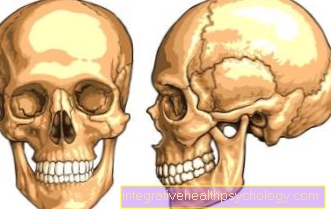The lymphatic system
introduction
The human lymphatic system is a blood vessel-like system that spans the entire body. It carries the lymph fluid, which is important for immunological defense processes.

Structure of the lymphatic system
The lymphatic system is divided into different sections. The smallest capillaries reaching into the intercellular spaces have an almost invisible cross section. Here, among other things, the lymph fluid is formed and passed on. The capillaries unite with other capillaries of the same size and form the pre-collectors, which are somewhat larger on average. These are then brought together further and then form the even larger collectors.
Sometimes lymph vessels are located directly next to and on top of each other in certain places. This is to ensure that lymph fluid is evenly distributed in the body and that pathogens can be transported from different areas of the body. In the places where the lymph vessels are above or directly next to each other, there are so-called Anastomoses. Anastomoses are short circuits that ensure that two closely spaced lymph vessels are connected. The lymph fluid can thus be exchanged between the upper and lower layers without any loss of time. The lymphatic system is interrupted in certain places in the body. Filtering stations are installed here, which ensure that the lymph fluid cannot move unfiltered in the body. The filtration stations consist of the lymph nodes, of which there are almost innumerable in the body. At the filtration stations, however, the lymph nodes are densely packed.
Read more on this topic: Lymph nodes
The most important lymph node stations are in the groin, armpit and neck area. There are also numerous lymph nodes in the neck and represent another filtering station. The lymphatic system flows into the venous blood system in the so-called venous angle. Here is the sensitive part of the lymphatic system. If pathogens have made it this far without being stopped, there is a great risk that they will pass into the blood system and lead to blood poisoning there.
Read more on this topic: lymph vessels
Illustration of the lymphatic system

Lymphatic system
- Head lymph nodes -
Nodi lymphoidei capitis - Cervical lymph nodes -
Nodi lymphoidei cervicales - Mouth of the breast duct
in the left arm-head vein -
Thoracic duct
Left brachiocephalic vein - Mouth of the right main
lymph duct in the right
Arm head vein -
Dexter lymphatic duct
Vena brachiocephalica dextra - Superior vena cava -
Superior vena cava - Axillary lymph nodes -
Nodi lymphoidei axillares - Milk breast duct -
Thoracic duct - Lymph vessels -
Vasa lymphatica - Abdominal lymph nodes -
Nodi lymphoidei abdominis - Pelvic lymph nodes -
Nodi lymphoidei pelvis - Inguinal lymph nodes -
Nodi lymphoidei inguinales - Mandibular lymph nodes -
Nodi lymphoidei submandibulares - Anterior cervical lymph nodes -
Nodi lymphoidei cervicales anteriores - Superficial lateral cervical lymph nodes -
Nodi lymphoidei cervicales
lateral superficiales - Deep lateral cervical lymph nodes -
Nodi lymphoidei cervicales
lateral profundi - Mastoid lymph nodes -
Nodi lymphoidei mastoidei - Occipital lymph nodes -
Nodi lymphoidei occipitales - Facial lymph nodes -
Nodi lymphoidei faciales - Parotid lymph nodes -
Nodi lymphoidei parotidei
You can find an overview of all images from Dr-Gumpert under: medical images
Function of the lymphatic system
The lymphatic system has two major roles. The first task is to maintain the Metabolic transport and the corresponding distribution in the body. Fats that are absorbed in the intestine are transported with the lymph fluid.
The second task is that Protective function against pathogens. In the lymph nodes, the "control points" of the lymphatic system, the pathogens are fought by immune cells.
Tasks in the regulation of the metabolism
A not inconsiderable amount of it is present in the body via the lymph fluid Liquid transported back and forth. The blood vessel system, which runs parallel, carries blood sometimes under high pressure and it always happens that liquid diffuses out of the vascular system. If this liquid were not removed, water would be retained. The The lymphatic system absorbs this fluid that has remained between the cells and leads it over the entire lymphatic system back into the venous angle where it is returned to the blood vessel system.
The Transport of fats also takes place partly via the lymphatic system. Fats that are important for the metabolism are absorbed with food. So that they can get into the blood, the lymph fluid that passes the intestine absorbs these fats and transports them over the entire lymphatic system to the venous corner, where the fat is returned to the blood system and distributed in the body and thus to the cells for the metabolism Available.
Function of the lymphatic system in defense against pathogens
The most famous task of the lymphatic system is that immunological response to pathogensthat enter the body. The first hurdle is the skin barrier, which is initially intended to prevent pathogens from entering the body. Mucous membranes also contain weird cells and antibodies. Another filtering station is the lymphatic system. If the pathogens reach this point, the lymphatic system picks up the pathogens in order to prevent them from entering the bloodstream. At each lymph node station, the lymphatic system tries to eliminate the pathogens. There are numerous lymph nodes at each lymph node station. If the lymph nodes have to deal with a pathogen, they swell and can be painful.
The superficial lymph nodes, which are sometimes noticed as painful swellings on the neck, e.g. in the case of flu, are only a small part of the lymph node system. Most lymph nodes are deeper and cannot be palpated from the outside. Even so, the palpation of the important superficial lymph node stations often delivers important diagnostic information.
If the pathogens survive this first filtering station, they continue to swim through the lymphatic system, perhaps even in smaller numbers, and soon reach the next lymph node station, where another one Defense process is started. The pathogens should be largely eliminated before they can flow into the vein corner that is close to the heart. If the lymphatic fluid has not been completely cleaned and the pathogens in the Vascular system reach, it can lead to life-threatening blood poisoning, which must be treated urgently with antibiotics. Most pathogens, however, are successfully eliminated. In particular, small amounts of pathogen that enter the body, for example through a skin incision, are generally not dangerous to humans.
Diseases of the lymphatic system
Diseases of the lymphatic system can be caused by drainage disorders or infections.
When a large number of pathogens enter the body and the lymph fluid transports these pathogens from lymph node station to lymph node station, the vessel can become inflamed. One also speaks of a so-called lymphangitis. Lymphangitis is usually visible through a red stripe on the forearms. This is popularly known as "blood poisoning". If there is no antibiotic treatment, the strip moves further and further upside down. As a complication, lymphangitis can result in a painful and / or swollen arm in addition to the red stripe. In addition to antibiotic treatment, the arm should be immobilized and cooled and treated with anti-inflammatory drugs.
Read more on this topic: Lymphangitis - How Dangerous Is It?
Another very common disease of the lymphatic system is congestion of the lymphatic system. It can occur at any position in the lymphatic system and have various causes. Very often particularly warm days are to blame for congestion processes in the lymphatic system. The result is water retention, which is noticeable as swelling of the feet or legs. Sitting or standing for long periods of time can also have the same effect.
Read more on this topic: Edema
Lymph node enlargement can also lead to congestion of the lymphatic drainage. Lymph node enlargements are mostly caused by infections and an expression of the normal and necessary defense reaction of the body. However, if they occur in unusual places or if they continue to progress without an infection, in rare cases there may be other causes such as leukemia or lymphoma, which should be investigated.
Read more on this topic: Lymph node enlargement - how dangerous is it?
A very extreme congestion of lymphatic drainage is the so-called Elephantiasis. In most cases, one leg swells many times over. In addition to the exact search for the cause, regular lymphatic drainage should be carried out for all lymph drainage disorders. With this measure, which is part of physiotherapy, the excess lymph fluid is evenly distributed in the lymphatic system using regular pressure and pushing techniques.





























